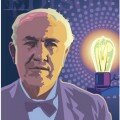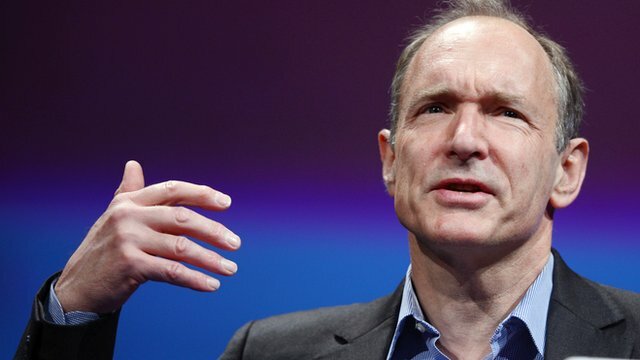 Sir Tim Berners-Lee is a British computer scientist who’s best known as the inventor of the World Wide Web, the foundation for todays Internet. The Queen knighted Sir Tim Berners-Lee in 2004 for his work and he’s well recognised by many around the globe as one of the biggest world changers of the last few decades – pivoting the world into a whole new direction of global connectivity, sharing and communication.
Sir Tim Berners-Lee is a British computer scientist who’s best known as the inventor of the World Wide Web, the foundation for todays Internet. The Queen knighted Sir Tim Berners-Lee in 2004 for his work and he’s well recognised by many around the globe as one of the biggest world changers of the last few decades – pivoting the world into a whole new direction of global connectivity, sharing and communication.
The Life Biography of Tim Berners-Lee
Tim Berners-Lee was born in Southwest London on the 8th Jun 1955 to Mary Lee Woods and Conway Berners-Lee. His family including 3 siblings was a techy bunch as a whole and his parents had worked on the first commercially built computer of the era, the Ferranti Mark 1.
During his early life, Tim attended Sheen Mount Primary School before moving on to attend London’s independent Emanuel School during his teenage years from 1969 to 1973. It was during these years that he learnt about electronics through his model railway and related trainspotting interests.
Following his conclusion of schooling at Emanuel Independent School in 1973, Tim went on to study a first-class degree in physics as The Queens College of the University of Oxford. He studied there for 3 years between 1973 and 1976 and no doubt, spent some of his time furthering his already expansive knowledge of electronics.
The Start of a Career
Following his Graduation from The Queens College in 1976, Berners-Lee moved on to work as an engineer at a Telecommunications Company in Poole before later joining D.G. Nash in Dorset two years later. There he helped in creating typesetting software for printers.
In 1980, the real beginnings of Berners-Lee’s progression towards the World Wide Web came as he worked as an Independent contractor at CERN. He stayed there for just 7 months, but while there proposed a project based on the concept of hypertext and demonstrated the idea with a simple prototype system he’d built called ENQUIRE.
The system was proposed at CERN as a solution to sharing and updating information among researches, but later would form part of his invention for the Web.
He left CERN in late 1980 and went to work at John Poole’s Image Computer Systems, Ltd in Bournemouth, England where he ran the technical side of the company for the following 3 years. One of the projects he ran there included a ‘real-time remote procedure call’ which gave him further experience in computer networking and the process of sharing information from computer to computer.
The Introduction of the Internet
In 1984 he returned to CERN and in 1989, with CERN then the largest Internet node in Europe saw his opportunity and came up with the idea of joining his previously throughout hypertext with the Internet.
He wrote his first proposal for the idea in March 1989 and in 1990 produced another version with help from Robert Cailliau, which together they presented to his manger.
The proposal was accepted by Tim’s Manager at CERN and he went on to build the World Wide Web using the ENQUIRE system he’d developed around a decade earlier and creating a brand new Web Browser for the service.
Creating the web was really an act of desperation, because the situation without it was very difficult when I was working at CERN later. Most of the technology involved in the web, like the hypertext, like the Internet, multi-font text objects, had all been designed already. I just had to put them together. It was a step of generalising, going to a higher level of abstraction, thinking about all the documentation systems out there as being possibly part of a larger imaginary documentation system. - Sir Tim Berners-Lee
The web was now up and they began to work on the first ever website. It was a simple website, based at the Web address Info.cern.ch and provided an explanation of what the World Wide Web was, how someone could use a browser, search for information and create their own Web page.
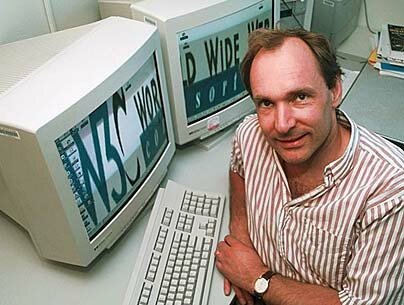
Berners-Lee founded the W3C at Massachusetts Institute of Technology in 1994, where standards and recommendations to improve the quality of the Web were made.
However, Berners-Lee applied for no patent, demanded no royalties and instead made his idea available to the masses for free. The World Wide Web Consortium (W3C) agreed with this and decided its standards would be based on the Web being a royalty-free technology – making it easily adopted by anyone.
Moving into the 21st Century
Moving on and a decade later, in 2004, Berners-Lee accepted a chair in Computer Science at the University of Southampton’s School of Electronics and Computer Science. There he began work on the semantic Web, a collaborative version of the web including semantic content.
In 2009, again another 5 years later and Gordon Brown, the British Prime Minister at the time announced Berners-Lee would begin to work with the UK Government on a project to make data and information more open, free and accessible on the web.
Berners-Lee spoke about the project in April 2010 and said, “The changes signal a wider cultural change in Government based on an assumption that information should be in the public domain unless there is a good reason not to – not the other way around.”
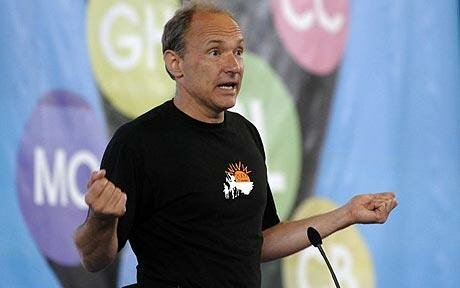
In October 2013, the Alliance for Affordable Internet (A4AI) was launched and Berners-Lee set up and ran a coalition of public and private Internet influencing organizations including the biggest of them all, Google, Facebook, Microsoft and Intel. The Alliance aims to make Internet access more affordable and increasingly broaden access to it in the developing world.
Awards
Sir Tim Berners-Lee has gained a wide range of awards and honors during his life and career. They include awards such as the Software System Award, which he received from the Association for Computing Machinery in 1995, OBE’s and KBE’s from the Queen, and various degrees’ including an honorary Doctor of Science degree from Harvard University in May 2011.
Lessons from Sir Tim Berners-Lee & His Internet
Living in the era of the Internet and a digital world which is growing faster and stronger than ever before, there’s a lot we can learn from the man who kick-started it all.
Without Sir Tim Berners-Lee there may have been no Internet, any such thing as an online search engine, and certainly nothing like the social media, blogging and online shopping as there is today.
And so with this, we can learn a lot from both Sir Tim Berners-Lee and his creation in a variety of ways but I believe the most significant and individual of them all, are those I’ve listed below.
Be Aware of Other Potential World Changers
It may feel like you’re alone in your little world, in fact it almost always does in mine to, but you’re not. If you’re aim in life is to have an impact on the world, then you’re not alone and there are thousands of others around the globe with the same vision and dedication to change to.
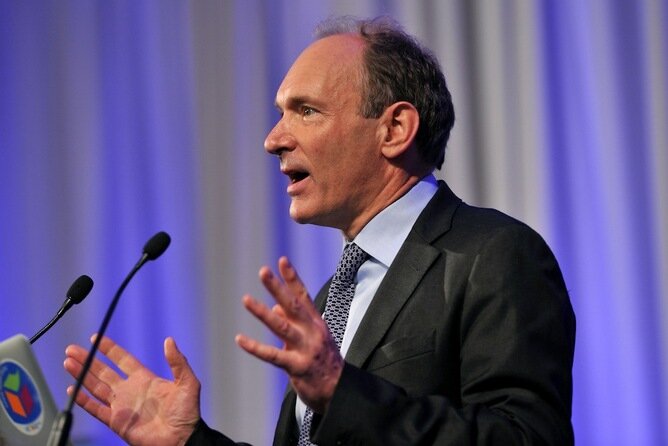
“I’m very aware,” says Sir Tim, “there are lots of other people who are just as bright and working just as hard, with just the same dedication to make the world a good place.”
And whether you find that inspiring, motivating, helpful or not, it’s true. So use it, find those people, meet with them and discuss your visions, thoughts and ideas together.
With today’s Internet enabled social media we really have no excuse. Contacting and keeping in touch with other like-minded people has never been this easy before and if you’re not on it, then you’re missing a real 21st Century world changers trick.
You Affect the World by What You Browse
My second lesson from Sir Tim Berners-Lee is perhaps another lesson, which is not directly from him, but instead one, which I always infer from the inspiration that the opportunities of his Internet developments have come to offer.
We now live in a world where information is at our finger tips, social contact is in front of our eyes and the ability to work on our projects can be done from almost anywhere on the planet – they even have the Internet in space you know!
We’ve never been in a place like this before and the possibilities for this age are endless. Sir Tim Berners-Lee once said, “You effect the world by what you browse”, a simple and short quote but one that for me sums up the Internet, its offerings and its potential doings for our future as a whole.
From what we browse, learn, develop and the connections we make while online, we increase our knowledge and broaden our minds.
Nelson Mandela once said that “Education is the most powerful weapon which you can use to change the world” and with that, the Internet is the most powerful platform to inform and expand on your education.
The Internet is not just a go to tool like the steam engine of the Industrial Revolution, but is instead a constant extension of our minds and ourselves for this Digital one. It’s a modern day version of the library, workshop and networking events of the past, but now combined and condensed into a single little box, the mobile phone.
So for me, this century is the century of learning, networking, sharing and developing, and I believe it’ll be the century of great achievement for the human race.
So now a final question for you: what will you’re part be? Instead of Googling for the latest funny news, the latest silly picture or the latest video from your night out with the lads… why not use the internet constructively, positively and develop your mind to accomplish great things in your future. After all, in the words of Sir Tim Berners-Lee, you do “affect the world by what you browse.”
Wrote by Joe Brown – Follow Me – Part of the Lives & Lessons Series



